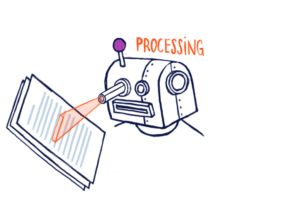
Artificial Intelligence (AI) has become an integral part of our lives, from recommending movies on Netflix to predicting stock market trends. In academia, AI has been a game-changer, especially in research fields. Due to its capacity to process large datasets, recognize patterns, and even make predictions about outcomes, AI has become a handy tool in the academic world (Bohr & Memarzadeh, 2020).
The landscape of postgraduate research is being reshaped by artificial intelligence, which helps with elements of dissertations such as literature reviews and statistical data analysis. In particular, doctoral students are at the center of this revolution in artificial intelligence. According to Joksimovic et al. (2023), “Artificial intelligence tools are an appealing solution for postgraduate students because of the pressures associated with producing novel research and the sheer volume of information they need to process” (p.2). Using these AI tools promises to be both efficient and comprehensive, thereby assisting students in more effectively navigating the complex dissertation research landscapes they face.
A comprehensive survey by Van Noorden and Perkel, published in the Nature Journal in 2023 highlighted that artificial intelligence (AI) tools are becoming increasingly common in scientific research (Van Noorden & Perkel, 2023). The survey, which included more than 1,600 researchers worldwide, found that many scientists anticipate that AI tools will soon be central to the practice of research. Yet another study conducted in 2023 showed that nearly half of all college students were using AI tools, with a significant increase in usage observed from spring to fall of the same year (Coffey, 2023).
This study also revealed that students were outpacing faculty in AI adoption. This statistic highlights the rapid adoption of artificial intelligence in academic settings and the growing reliance on AI. Dr. Emma Johnson, a renowned expert in artificial intelligence (AI), has extensively studied the ethical implications of AI in society (Johnson et al., 2023). She emphasizes that while AI is becoming increasingly prevalent and has the potential to revolutionize various sectors, including research, it is not without its limitations.
The Evolution of AI

Artificial intelligence has been around for decades. Theseus was the first remote-controlled mouse created in the 1950s by a computer scientist who could find its way around a maze and remember its path (Sharkey & Sharkey, 2009). Since then, the growth of AI capabilities has been initially gradual. However, thanks to improvements in computer speed, cloud computing, and the abundance of large data sets, artificial intelligence has experienced significant progress.
Today, it’s easier than ever for individuals to utilize programs such as ChatGPT to engage in text-based conversations (Kim, 2019). You can also employ platforms such as Cyphon Ai to automate data analysis and research workflow. Additionally, AI technology is being employed by various industries for a wide range of applications, including the development of autonomous vehicles, interpreting radiographs, and determining airline ticket prices, to name a few.
Even though the benefits of artificial intelligence in research cannot be refuted, this powerful technology has its own challenges and dangers. Inappropriate use of artificial intelligence can result in significant academic and ethical problems, potentially derailing an entire PhD journey. As a result, it is of the utmost importance for researchers to have a solid understanding of how to effectively incorporate artificial intelligence into their work, ensuring that it not only compromises but also enhances the integrity and quality of their research. In this blog, I highlight the potential pitfalls of the improper use of artificial intelligence in academic research and offer advice on navigating these challenges effectively.
Misusing AI in PhD Research

AI tools have become the Swiss Army knives of the modern researcher’s toolkit, offering a range of capabilities from automating tedious tasks to uncovering hidden patterns in data. However, like any powerful tool, they must be used judiciously. Misusing AI can lead to significant pitfalls in your PhD journey, potentially derailing your research and tarnishing your academic reputation. Let’s explore some common misuses of AI in PhD research and how to avoid them.
Over-Reliance on AI for Data Analysis
Picture yourself on a lengthy trek through unfamiliar terrain. While you may have the latest and most outstanding GPS device, will you overlook the reliability and usefulness of a good old compass and map? Most likely not. Yet, numerous researchers find themselves in the predicament of excessively depending on AI for data analysis, similar to placing too much trust in a GPS without having a contingency plan. Let’s see some examples.

- Blind Trust in AI: One of the most severe risks of using AI is placing blind trust in its results. AI algorithms can quickly handle large amounts of data but are imperfect. They may make mistakes, mainly if the input data is flawed or biased. Accepting AI-generated results without thoroughly understanding the algorithm’s operation or assumptions can lead to incorrect conclusions (Labajová, 2023). For example, during statistical analysis, an AI tool may detect a correlation between two variables. Still, unless you understand the underlying algorithms, you may miss critical specifics such as spurious correlations or overlooked confounding variables.
- Lack of Validation: Just as a scientist would conduct multiple experiments to validate their findings, it is important to cross-check AI-generated data. It is essential to validate AI results using traditional methods or manual checks. This could include conducting parallel quantitative analyses using conventional statistical methods or manually inspecting the data. According to Tsopra et al. (2021), validation of AI-generated data is crucial, especially in healthcare research, in ensuring the accuracy and dependability of the findings. Not taking this step can result in an inflated sense of confidence in AI results, which could lead to unreliable research findings.
- Complexity of Data: AI tools tend to oversimplify complex connections, which can result in misunderstandings (Labajová, 2023). A thorough examination is necessary for complex datasets, whether they are analyzed manually or with AI. For example, an AI model might poorly understand high-dimensional data or datasets with intricate interactions, which could miss subtle but significant patterns. As a researcher, it’s your responsibility to understand the limitations of the AI tools you are using and to interpret their outputs critically. Understanding the “why” behind the “what” requires more than accepting the results at face value. It involves diving into the data and the model to gain deeper insights.
Plagiarism
In the digital era, where AI tools can generate text in the blink of an eye, the lines between original thought and machine-generated content can blur. This convenience has many potential pitfalls that can ensnare even the most diligent researchers. Let’s explore the challenges of plagiarism and intellectual property when using AI in your PhD research.

- AI-Generated Texts: Picture this: you’re racing against a deadline, and an AI tool promises to draft a section of your dissertation, for instance, a discussion section, in minutes. Tempting, right? While AI-generated text can save time, it also introduces the risk of unintentional plagiarism (Santra & Majhi, 2023). These tools frequently gather information from a wide range of sources, and unfortunately, some of these sources may not receive proper credit. Using AI to generate text without understanding its sources can result in passing off someone else’s work as your own. This not only undermines your integrity but also violates academic standards.
- Proper Citation: Citing AI-generated content correctly is crucial to maintaining academic integrity. Just as any student doing scholarly writing would cite a journal article or book, any text produced by an AI should be appropriately attributed. This can be tricky, as AI tools may not have a clear author or publication date. However, it is crucial to recognize the utilization of AI tools and thoroughly explain their application in your research. Failure to do so can lead to accusations of academic misconduct. Being transparent in your methods strengthens your credibility and enables your peers to comprehend and reproduce your work.
Misinterpretation of AI Outputs
In the whirlwind of technological advancements, AI has become a beacon of promise for researchers, offering the ability to analyze statistical data at unprecedented speeds and depths. However, this digital marvel is not without its shadows. Misinterpreting AI outputs can lead to significant errors and skewed findings, potentially derailing your research efforts. It is crucial to avoid misinterpreting AI outputs as it can result in substantial errors and distorted findings, ultimately hindering your research progress. Now, let us go into the complexities of this matter and discuss strategies for effectively navigating it.
- Bias in AI Models: Imagine feeding a high-quality camera with a smudged lens; no matter how advanced the camera, the pictures will be flawed. Similarly, AI models can reflect and even amplify existing biases present in their training data. For example, if an AI tool is trained on data that underrepresents specific demographics, its predictions and analyses will likely be biased. This can lead to skewed results that do not accurately represent the reality of your research topic.
- Understanding Limitations: Every tool has limitations, and AI is no exception. AI algorithms are designed to handle specific tasks within defined parameters. Overstepping these boundaries can result in misinterpretation. For instance, using an AI book and novel writing platform designed for natural language processing to interpret complex, domain-specific scientific texts might yield unreliable results unless integrated with the artistry of human writers. Understanding the scope and limitations of the AI tools you use is vital (Tsopra et al., 2021). This involves knowing what the AI can do and being aware of what it cannot do.
- Critical Thinking: AI can process and analyze qualitative and quantitative data but lacks the critical thinking and domain knowledge that human researchers bring (Spector & Ma, 2019). This is where your expertise comes into play. AI outputs should be seen as a starting point rather than definitive answers. Engage with the results critically, question anomalies, and cross-check findings with traditional methods and existing knowledge in your field. For example, if an AI model such as Cyphon Ai predicts an unexpected trend, investigate further to understand the underlying reasons. Is it a genuine discovery, or is there an issue with the data or algorithm?
Ethical concerns
Using AI in research raises ethical concerns around data privacy, security, transparency, and ownership. AI algorithms require large amounts of data to function, and it is important to ensure that the information that a PhD researcher uses is obtained ethically and with the proper consent of the individuals involved.
Additionally, using AI in research may lead to the commodification of data, where individuals ‘personal information is bought and sold without their knowledge or consent (Johnson et al., 2023). As a practical example, a researcher may collect personal data from individuals without their informed consent, or they may use data obtained unethically, such as hacking or unauthorized access. This can harm individuals, such as identity theft or financial fraud.
The AI Detectors: The Guardians of Originality

Universities and academic institutions are acutely aware of the surge in AI-generated content. To combat the potential misuse of AI tools like ChatGPT, they have implemented advanced AI detectors, which are the digital sentinels of academic integrity. The systems of AI detectors are designed to identify unoriginal work, including text generated by artificial intelligence (Sadasivan et al., 2024).
AI detectors operate by analyzing textual patterns, assessing consistency in writing style, and cross-referencing the content against a vast repository of academic sources and previously submitted works. For example, Turnitin, a widely used plagiarism detection service, has now integrated AI capabilities to spot AI-generated content by examining sentence structures, stylistic shifts, and vocabulary usage that may differ from the student’s usual writing style.
These tools can identify discrepancies, such as abrupt changes in tone or complexity, that might suggest using AI assistance. These detectors act as gatekeepers for PhD students seeking dissertation help who might be tempted to use AI-generated content without proper attribution. They ensure that all submitted work meets the standards of originality required in academia.
For instance, if a student submits a dissertation chapter that suddenly shifts in style or vocabulary, the AI detectors can flag these sections for further review by comparing them to the student’s previous submissions and academic writing samples. These digital watchdogs play a crucial role in maintaining the credibility of educational institutions. They prevent and penalize plagiarism from traditional sources or advanced AI tools. By doing so, they protect the value of academic achievements and uphold the principles of scholarly honesty, ensuring that all students’ work reflects their true capabilities and efforts.
Caught Cheating: Consequences in PhD Journey

In the digital age, AI tools like ChatGPT have become increasingly common among students. While these tools offer remarkable assistance in generating content, enhancing productivity, and even fostering creativity, their misuse can lead to severe consequences, especially in academic settings. For PhD students, who are expected to uphold the highest standards of academic integrity, being caught using ChatGPT by AI detectors can have particularly severe repercussions. Let’s now look at the potential consequences of such actions and explore the importance of maintaining ethical practice.
Academic Integrity Violations: One of the most immediate and serious consequences of being caught using ChatGPT by AI detectors is the violation of academic integrity policies. Academic institutions have strict rules against plagiarism and submitting work that is not entirely one’s own. Utilizing AI-generated content without proper attribution falls squarely into this category. PhD students guilty of such violations may face disciplinary actions, ranging from failing the assignment or course to expulsion from the institution. These penalties affect one’s academic record and tarnish the student’s reputation within the academic community.
Damage to Academic Reputation: PhD students work tirelessly to build a reputation based on their research, knowledge, and contributions to their field. Being caught using AI tools improperly in academic writing can significantly damage this reputation. Academic peers, advisors, and future employers value honesty and originality, and breaching these principles can lead to a loss of trust and respect. This loss can have long-term implications, affecting future research opportunities, collaborations, and career prospects.
Impact on Research Validity: The integrity of research is paramount in academia. Using AI-generated content without proper oversight or attribution can compromise the validity of one’s research. Suppose AI detectors reveal that significant portions of a dissertation or thesis, such as a literature review or problem statement, were generated by an AI tool. In that case, the entire body of work may be questioned. This scrutiny can invalidate the research, resulting in the revocation of degrees and the nullification of published papers. For a PhD student, this scenario is nothing short of catastrophic, undoing years of hard work and dedication.
Legal and Ethical Implications: Beyond academic consequences, there are also legal and ethical implications to consider. Many institutions have honor codes and ethical guidelines that students must adhere to. Violating these can lead to legal repercussions, especially if using AI tools breaches copyright laws or intellectual property rights. Ethically, PhD students are expected to contribute original thought and knowledge to their field. Using AI-generated content without proper disclosure undermines this ethical commitment and can lead to a broader discussion about the role and limits of AI in academia.
Psychological and Emotional Toll: The fallout from being caught using AI tools inappropriately can also take a significant psychological and emotional toll on students. The stress of facing disciplinary actions, the stigma of being labeled a cheater, and the potential derailment of one’s academic and professional career can lead to anxiety, depression, and a loss of motivation. Maintaining mental well-being is crucial for academic success, and such incidents can severely impact a student’s mental health.
Mastering Your PhD with AI: Essential Tips and Tricks for Success

As a student seeking dissertation help, I find the allure of artificial intelligence tools difficult to resist. They promise to be quick and efficient, as well as capable of completing tasks that were previously thought to be impossible to achieve. Furthermore, just as an experienced explorer would not rely solely on a single tool for survival, a researcher must use artificial intelligence as a component of a larger arsenal to be successful. Learn how to integrate artificial intelligence into your PhD journey in an effective and ethical way.
Integration, Not Replacement: Imagine artificial intelligence as a powerful ally in your research work rather than the protagonist of the story. Here, the key is to have artificial intelligence integrated in a way that enhances your human expertise rather than replacing it. Here is how you can approach this:
- Complementary Use: Just like I have mentioned earlier, AI can swiftly analyze large datasets, identify patterns, and even suggest potential correlations. However, your role as a researcher is to interpret these findings and understand their context. For example, AI might highlight a trend in your data, but understanding the significance of this trend within your field requires human insight and expertise. This complementary use ensures that while AI handles the heavy lifting of data analysis processing, you retain control over the narrative and direction of your research.
- Balanced Approach: Adopting a balanced approach means leveraging AI for routine, time-consuming tasks, thus freeing you to focus on critical thinking, hypothesis generation, and topic development. Consider AI as your diligent assistant, taking care of mundane tasks like data cleaning, preliminary analysis, and even parts of literature reviews, which can be automated to some extent. This allows you to dedicate more time to creative and intellectual pursuits, such as developing new hypotheses, designing experiments, and critically analyzing results. According to Labajová (2023), you maximize efficiency without sacrificing the depth and rigor of your research by striking a balance between AI and human interpretation.
Critical Evaluation of AI Outputs: The promise of AI in research is undeniable, but with great power comes great responsibility. Critical evaluation of AI outputs is essential to ensure that the results are accurate, relevant, and free from bias. Here’s how you can rigorously assess the outputs of AI tools in your PhD dissertation research.
- Validation Methods: Relying solely on AI-generated results without validation can lead to misleading conclusions (Sadasivan et al., 2024). For instance, if your AI tool identifies a trend in your data, it’s crucial to verify this trend manually using established statistical techniques. Traditional statistical analysis methods like regression analysis, hypothesis testing, or even manual data inspection can confirm the AI’s findings and ensure they are not algorithm artifacts. This practice strengthens your research and builds trust in your findings among your peers and reviewers.
- Bias Detection: To detect bias in AI output, it’s essential to be aware of these biases and take steps to correct them. For example, if an AI model used for social research shows a bias against a particular demographic, this needs to be identified and addressed. Understanding the data and the algorithms you are using is the first step in detecting bias. Techniques such as fairness-aware machine learning and bias auditing can help mitigate these issues, ensuring your results are more equitable and accurate.
- Human Oversight: AI can process data and generate insights, but it lacks the contextual understanding that human researchers bring. Maintaining human oversight over AI processes, especially in quantitative or qualitative data analysis, is essential to ensure that the results are accurate and contextually relevant. As a researcher, you should critically review AI outputs, ask questions, and apply your domain knowledge to interpret the results. This oversight ensures that AI-generated insights are not taken at face value but are carefully considered and validated within the context of your specific research goals.
Proper Citation and Acknowledgment: In the age of AI, maintaining academic integrity involves more than just traditional practices. It’s about recognizing and crediting the digital tools that assist your research. Just as you would cite a pivotal study or a foundational theory, acknowledging the role of AI tools in your work is crucial. Let’s explore how to do this effectively. Here is how you can approach this:
- Crediting AI Tools: Think of AI tools as invaluable collaborators in your research journey. Just as you wouldn’t omit a co-author’s contribution, it’s essential to cite the AI tools and algorithms you use. This not only upholds academic integrity but also provides a clear trail for future researchers to follow. When you use AI for statistical data analysis, text generation, or any other purpose, include proper citations in your references. For example, if you used a specific AI tool like GPT-4 for generating text or analyzing data, your citation might look something like this: “OpenAI. (2024). GPT-4. Retrieved from [URL]”. This practice ensures that credit is given where it’s due and maintains the transparency of your research.
- Transparency in Methodology: Transparency in your qualitative, quantitative, or mixed-method methodology is crucial for replicability and credibility. When you incorporate AI into your research, provide detailed information on how these tools were used (Sadasivan et al., 2024). Specify the AI models and tools, the version numbers, and the specific tasks they performed. For instance, if you used an AI algorithm to analyze survey data, describe the algorithm’s parameters, the training data, and the preprocessing steps. This level of detail enhances your work’s transparency and allows other researchers to understand and potentially replicate your findings.
- Institutional Guidelines: Each institution may have specific guidelines regarding the use of AI in research. Familiarize yourself with these policies to ensure compliance and avoid ethical or academic misconduct. These guidelines often cover aspects such as proper citation, permissible uses of AI, and reporting requirements. Adhering to these institutional standards not only protects you from potential issues but also aligns your research with accepted ethical practices. Regularly review your institution’s policies and seek guidance from advisors or ethics committees if you’re unsure about specific aspects of using AI in your research.
Conclusion
As we explore the possibilities of AI in academic research, it becomes evident that this powerful technology has the capacity to revolutionize our PhD journeys greatly. However, the consequences of getting caught using AI tools like ChatGPT highlight the importance of using AI responsibly and with transparency. As AI continues to evolve, it’s crucial to navigate the ethical and practical aspects of its use, ensuring that it enhances, rather than undermines, our efforts.
You can leverage AI effectively by validating AI outputs with traditional methods, staying updated with advancements, and critically evaluating results. Embracing AI responsibly means using it to enhance your capabilities, freeing you to focus on creative and intellectually demanding aspects of your work. Ultimately, the responsible use of AI can significantly enhance your PhD journey, making your research more efficient, insightful, and impactful, transforming AI from a deceptive guide to a powerful ally in your academic progress.
References
Bohr, A., & Memarzadeh, K. (2020). The rise of artificial intelligence in healthcare applications. Artificial Intelligence in Healthcare, 25–60. https://doi.org/10.1016/B978-0-12-818438-7.00002-2
Coffey, L. (n.d.). Students Outrunning Faculty in AI Use. Inside Higher Ed. Retrieved July 14, 2024, from https://www.insidehighered.com/news/tech-innovation/artificial-intelligence/2023/10/31/most-students-outrunning-faculty-ai-use
Johnson, E., Parrilla, E., & Burg, A. (2023). Ethics of Artificial Intelligence in Society. American Journal of Undergraduate Research, 19(4).
Joksimovic, S., Ifenthaler, D., Marrone, R., De Laat, M., & Siemens, G. (2023). Opportunities of artificial intelligence for supporting complex problem-solving: Findings from a scoping review. Computers and Education: Artificial Intelligence, 4, 100138. https://doi.org/10.1016/j.caeai.2023.100138
Kim, K. (2019). Creating Space for Student Engagement With Revision: An Example of a Feedback-Rich Class for Second-Language Writers. Journal of Response to Writing, 5(2). https://scholarsarchive.byu.edu/journalrw/vol5/iss2/8
Labajová, L. (2023). The state of AI: Exploring the perceptions, credibility, and trustworthiness of the users towards AI-Generated Content. https://urn.kb.se/resolve?urn=urn:nbn:se:mau:diva-61215
Sadasivan, V. S., Kumar, A., Balasubramanian, S., Wang, W., & Feizi, S. (2024). Can AI-Generated Text be Reliably Detected? (arXiv:2303.11156). arXiv. https://doi.org/10.48550/arXiv.2303.11156
Santra, P. P., & Majhi, D. (2023). Scholarly Communication and Machine-Generated Text: Is it Finally AI vs AI in Plagiarism Detection? Journal of Information and Knowledge, 175–183. https://doi.org/10.17821/srels/2023/v60i3/171028
Sharkey, N., & Sharkey, A. (2009). Electro-mechanical robots before the computer. Proceedings of the Institution of Mechanical Engineers, Part C: Journal of Mechanical Engineering Science, 223(1), 235–241. https://doi.org/10.1243/09544062JMES1262
Spector, J. M., & Ma, S. (2019). Inquiry and critical thinking skills for the next generation: From artificial intelligence back to human intelligence. Smart Learning Environments, 6(1), 8. https://doi.org/10.1186/s40561-019-0088-z
Tsopra, R., Fernandez, X., Luchinat, C., Alberghina, L., Lehrach, H., Vanoni, M., Dreher, F., Sezerman, O. U., Cuggia, M., de Tayrac, M., Miklasevics, E., Itu, L. M., Geanta, M., Ogilvie, L., Godey, F., Boldisor, C. N., Campillo-Gimenez, B., Cioroboiu, C., Ciusdel, C. F., … Burgun, A. (2021). A framework for validating AI in precision medicine: Considerations from the European ITFoC consortium. BMC Medical Informatics and Decision Making, 21, 274. https://doi.org/10.1186/s12911-021-01634-3
Van Noorden, R., & Perkel, J. M. (2023). AI and science: What 1,600 researchers think. Nature, 621(7980), 672–675. https://doi.org/10.1038/d41586-023-02980-0
